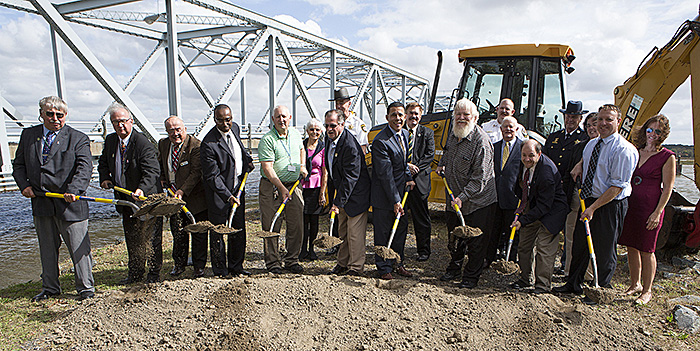EASTON, Md. (October 14, 2014) – Today, Lt. Governor Anthony G. Brown was joined by Transportation Secretary James T. Smith, Jr., state and local officials, emergency services personnel, and area residents for a groundbreaking ceremony to officially celebrate the start of construction for the $64.5 million project to build a new Dover Bridge carrying MD 331 over the Choptank River on Maryland’s Eastern Shore. Replacing the existing 82-year-old swing-span bridge, which connects Talbot and Caroline counties, has been a top transportation priority for local officials, emergency responders and residents for years due to safety concerns and congestion caused by frequent openings, breakdowns and maintenance repairs.

“The wait is finally over for the thousands of Eastern Shore residents and first responders who rely on this bridge every day and have long advocated for its replacement,” said Lt. Governor Brown. “Our investments in a new bridge, along with more than $200 million in priority projects across the Eastern Shore, will create jobs, spur economic development and enhance traffic safety for more Maryland families.”
“A reliable and well maintained infrastructure is vital to creating jobs today in construction and jobs tomorrow through economic growth,” U.S. Senator Barbara A. Mikulski said. “The Dover Bridge is critical to communities in Caroline and Talbot Counties as an important artery for first responders, businesses, families and tourists. By enhancing the safety, efficiency and reliability of the Dover Bridge, we are laying the groundwork for jobs and the economic future of the Eastern Shore. I will continue to fight for smart funding through federal investments in Maryland’s highways and byways, ports and bridges.”
“The importance of a new Dover Bridge cannot be underestimated. The safety, livability and economic well-being of the Eastern Shore flow through, over, under and around this essential crossing,” said U.S. Senator Ben Cardin, a member of the Senate Environment and Public Works Transportation Infrastructure Subcommittee. “Robust investments in infrastructure create jobs and economic development across the region. The federal government has been such a strong partner throughout Maryland to modernize and improve the safety of our transportation choices. "
The new bridge is part of more than $200 million in key transportation investments being made throughout the Eastern Shore, which are helping to create approximately 1,900 jobs, thanks to funding from the Transportation Infrastructure Investment Act of 2013 and strong support from our federal partners. Approximately $51.5 million in Federal funding is being used to build the new bridge.
Utility work is now underway, with major construction work expected to begin in November. The new Dover Bridge is scheduled to be complete late 2017/early 2018, weather permitting. The swing-span bridge will remain open to traffic while the new bridge is built. The new bridge will be a high-level, fixed-span structure just south of the existing bridge. The new bridge will be 2,020 feet long with two 12-foot lanes, 8-foot shoulders, and 50-foot clearance above the Choptank River for marine traffic.
“Today’s Dover Bridge groundbreaking is another major milestone in the O’Malley-Brown Administration’s ongoing efforts to invest in crucial transportation projects that enhance safety, improve travel and create jobs,” said Transportation Secretary James T. Smith, Jr. “We are pleased to finally get this project underway for Eastern Shore residents.”
The existing Dover Bridge was built in 1932 and is a three-span, steel Warren truss bridge with a swing-span and concrete deck that carries two 12-foot lanes with no shoulders. When the swing-span bridge opens to marine traffic, vehicular traffic is halted on both sides. The delay for motorists is a concern among local residents, especially since it prevents access for emergency vehicles that serve one hospital for both counties.
Due to its age, the opening mechanisms of the bridge have been prone to break down. Additionally, the bridge is too narrow for modern standards and is nearing the end of its service life. The existing bridge, one of only three remaining swing-span bridges in Maryland and eligible for the National Register of Historic Places, will remain in an open position to allow marine traffic to pass and people to fish from either side of the structure. A seven-space parking lot will be constructed on the Caroline County side of the existing structure to accommodate people who want to fish from the historic bridge or enjoy recreational activity along the Choptank River.
As a result of the passage of the Transportation Act, which enabled the Maryland Department of Transportation to add $4.4 billion in new projects statewide, the O’Malley-Brown Administration announced more than $200 million in key transportation projects for Eastern Shore residents. Along with the Dover Bridge replacement, other key Eastern Shore transportation projects moving forward with funds from the Transportation Act include: constructing a new interchange at US 301/ MD 304 in Queen Anne’s County, widening MD 404 from west of MD 309 to Cemetery Road in Caroline and Queen Anne’s counties, widening US 113 to a four-lane divided highway from north of Five Mile Branch Road to south of Massey Branch in Worcester County; and constructing a roundabout along MD 822 at the entrance to the University of Maryland Eastern Shore in Somerset County.
# # #